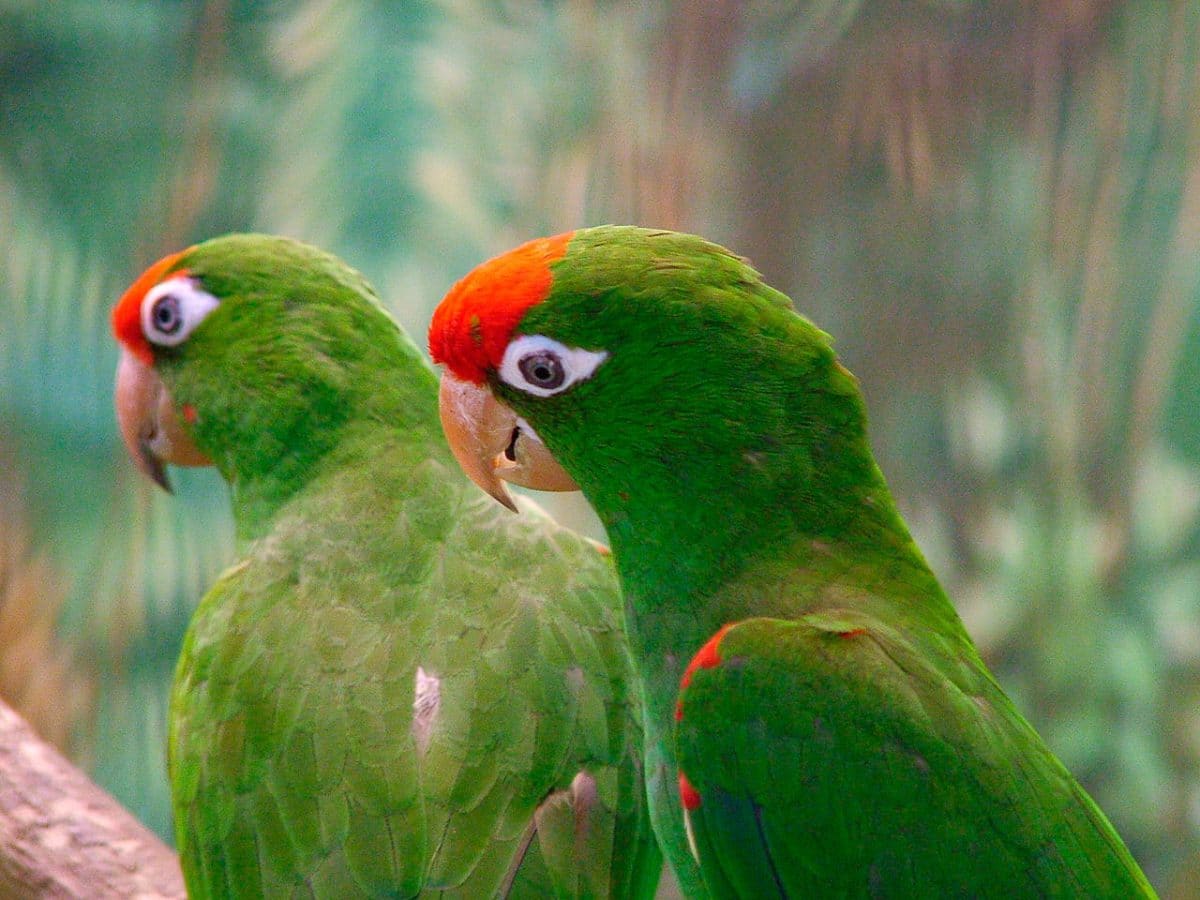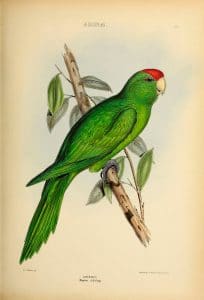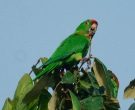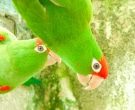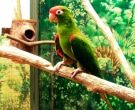Content |
|---|
Description:
34 to 36 cm.. of length and a weight of 162 to 217 g..
The Scarlet-fronted Parakeet (Psittacara wagleri) He has the crown and forecrown bright red; lores and cheeks dark green with red feathers scattered in some birds. Of the nape even up to the uppertail-coverts dark green. Upperwing-coverts dark green; flight feather green, dyed Emerald above and olivaceous at the bottom. The greater underwing-coverts, also of color olivaceous, the remaining underwing-coverts, green. The underparts brighter yellowish green, sometimes with scattered red feathers on the throat and in the the thighs. Upper, the tail dark green; by down olive green.
The bill color pale horn; bare periophthalmic grey; irises yellow; legs distant.
Both sexes similar.
The immature with a reduction (or even absence) Red Feather in the head.
- Sound of the Scarlet-fronted Parakeet.
Habitat:
Video – "Scarlet-fronted Parakeet" (Psittacara wagleri) |
|---|
They inhabit in humid forests, deciduous, from gallery, cloudy and second-growth forests with acacias, Prosopis and Ochroma, mainly in the lower subtropical and upper tropical zones, Although they can also penetrate in sub-templadas areas.
In Peru, observed in cloud forests semi-arid.
Reported at lower elevations in humid plantations, cornfields and cactus thickets. Key requirement in their habitat are the cliffs, in which it breeds and rests.
In general, observed the altitudes of 2.000 m, above the 3.000 metres in Peru. Gregaria, usually in close flocks to the 20 individuals, sometimes up to 300 birds.
Communal hangers on the cliffs with diurnal movements towards the areas of power.
Reproduction:
Nest communally in Rocky steep, between December and June in the North of Colombia and between April and June in Venezuela. Average of the laying of 3 to 4 eggs and the incubation is of 23 or 24 days. The pups they leave the nest after 50 days, with a plumage green.
Food:
Its diet includes a variety of fruits, nuts and seeds; You can include cereal crops and fruit plantations. Usually they feed in the canopy.
Distribution:
Size of the area of distribution (reproduction / resident): 866.000 km2
The Scarlet-fronted Parakeet It is distributed discontinuously in the northwest and west of South America, in the area of the Andes, from Venezuela until Peru.
In Venezuela stretching from West of the Paria Peninsula in the foothills of the Andes (between 500 and 2,000m, more altitude farther south), up to the Serrania del Perija and in the North of Colombia, including the Department of Magdalena and the West and center of the mountain range of the Andes Although apparently absent in the southwestern tip of Colombia.
Their status in the eastern slope of the Andes in Colombia is uncertain. Found around the skirts of the Andes in the South of Ecuador and South of Peru until Tacna at latitudes of I8° S.
Apparently, observed in the Western Andean slopes in the Peru with some reports from the South of the Valley of the Maranon River until Ayacucho and apurimac, in the central andes.
Usually residents Although seasonal visitors in some areas. Irregularly-common, often abundant, Although scarce or non-existent in many areas; more scarce in the South. Decrease in its population in some areas (for example, Colombia), due to loss of habitat.
Trapped for the trade in live birds, with 16.644 specimens exported from Peru in 1982.
The large number of birds escaped from her cage makes it considered them are introduced in Spain, Florida, Hawaii and California.
Conservation:
State of conservation ⓘ |
||
|---|---|---|
 Near Threatened ⓘ (UICN)ⓘ
Near Threatened ⓘ (UICN)ⓘ
| ||
• Red List category of the UICN current: Near-threatened
• Population trend: Decreasing
The population trend of the Scarlet-fronted Parakeet apparently it has not quantified, but you suspect that your decline It moderately fast due to the persecution and change of land use (pit et to the., 1997).
The species has been the subject of a intense trade and individuals captured in nature have been recorded in international trade (UNEP-WCMC trade database CITES).
One high internal trade This species has been observed in Venezuela (pit et to the., 1997).
Pursued, due to its status as a crop pest, It can also be contributing to their decline.
Current levels of hunting pressure and persecution are not known, but it is assumed that it is producing a negative trend in their population.
Although this species shows a flexible use of the habitat and makes use of the crops, It is suspected that the the land use change It is contributing to a population decline of the species, and habitat clearance is presumed that it has led to the decline of this species in Colombia (pit et to the. 1997).
Conservation Actions Underway:
• The species is listed in Appendix II.
Conservation Actions Proposed:
• Carry out surveys to assess the population size of the species and the trend.
• Quantify the current impact of entrapment.
• Monitor trade levels.
• Carry out awareness activities to reduce the activities of capture and trade of Psittacidas..
• Increase the area of suitable natural habitat that receives effective protection..
"Scarlet-fronted Parakeet" in captivity:
The poultry farming of the Scarlet-fronted Parakeet rarely achieved as this species is difficult to obtain and difficult to maintain. This Parrot will only spawn several years kept in captivity.
It is a bird animated, although, initially shy, that is because you provide a environment of Cologne, even in the breeding season. It´s resistant Once you have moved. Pretty noisy, something that must be taken into account if the neighbors are close.
Chomping hard, in need of a steady supply of fresh branches to meet the great need to chew. Enjoy the daily bath.
Alternative names:
– Scarlet-fronted Parakeet, Red-fronted Conure, Red-fronted Parakeet, Scarlet fronted Parakeet, Scarlet-fronted Conure (English).
– Conure de Wagler, Conure à front rouge, Perruche de Wagler (French).
– Columbiasittich (German).
– Periquito-de-cara-vermelha (Portuguese).
– Aratinga de Wagler, Perico Frentirrojo, Periquito de Frente Roja (español).
– Loro frentirrojo, Perico Frentirrojo, Perico Chocolero (Colombia).
– Cotorra de Frente Escarlata (Peru).
– Chacaraco (Venezuela).
– Perico frentiescarlata (Ecuador).
scientific classification:
– Order: Psittaciformes
– Family: Psittacidae
– Genus: Psittacara
– Scientific name: Psittacara wagleri
– Citation: (Gray, GR, 1845)
– Protonimo: Conurus Wagleri
Scarlet-fronted Parakeet pictures:
Sources:
– Avibase
– Parrots of the World – Forshaw Joseph M
– Parrots A Guide to the Parrots of the World – Tony Juniper & Mike Parr
– Birdlife
– Photos:
(1) – Scarlet-fronted Parakeet (Aratinga wagleri) at Jurong BirdPark, Singapore By Michael Gwyther-Jones (originally posted to Flickr as Singapore 2006 249) [CC BY 2.0], via Wikimedia Commons
(2) – Scarlet-fronted Parakeet, also called Scarlet-fronted Conure at Jurong Birdpark, Singapore By Lynn Zheng (bird park_012) [CC BY 2.0], via Wikimedia Commons
(3) – pericon found By the Selimalabi (Own work) [GFDL, CC-BY-SA-3.0 or FAL], via Wikimedia Commons By Selimalabi (Own work) [GFDL, CC-BY-SA-3.0 or FAL], via Wikimedia Commons
(4) – Chacaraco [Scarlet-fronted Parakeet] (Aratinga wagleri transilis) by barloventomagico – Flickr
(5) – Chacaraco / Scarlet-fronted Parakeet (Aratinga wagleri) by Erick Houli – Flickr
(6) – Illustration By Gray, George Robert; Hullmandel & Walton; Hullmandel, Charles Joseph; Mitchell, D. W. [CC BY 2.0 or Public domain], via Wikimedia Commons
– Sounds: (Xeno-canto)
